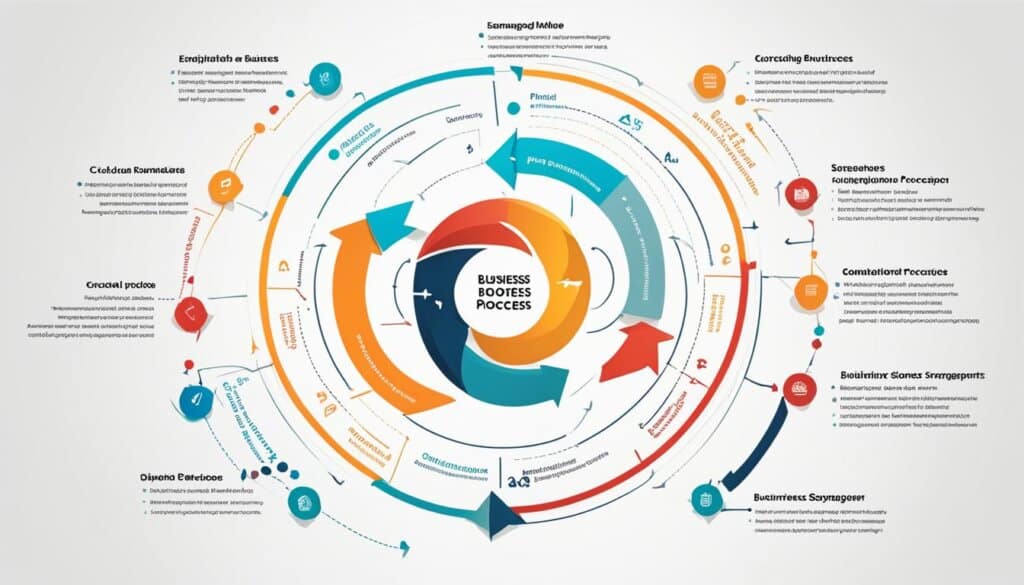Table of Contents
A business process is a set of activities that work together to achieve a specific organizational goal. It is a systematic approach to improving processes within an organization to achieve business goals. These processes may involve various departments, individuals, and technologies working in tandem to produce desired outcomes.
Business process management is the practice of analyzing, managing, monitoring, and modeling these processes to ensure they are operating smoothly and effectively. It helps identify areas for improvement and automates processes using technologies such as robotic process automation (RPA).
If an organization is unable to perform certain processes internally, they may opt for business process outsourcing. This entails assigning specific tasks or functions to external service providers who specialize in those areas. Outsourcing allows organizations to focus on core duties while reducing costs and leveraging specialized expertise.
Why are business processes important?
Business processes are essential for organizations to achieve their organizational objectives. They play a crucial role in breaking down work into organized, repeatable steps that ensure consistent outcomes. By implementing defined business processes, organizations can accurately predict resource needs and minimize the risk of errors and disruptions.
One of the key advantages of having well-defined business processes is the ability to measure the efficiency and effectiveness of each step. By analyzing individual steps, organizations can identify inefficiencies and bottlenecks that may hinder productivity or impact customer satisfaction. This allows them to implement continuous improvement measures and optimize their processes for better outcomes.
Furthermore, business processes help organizations address resource constraints. By understanding the requirements of each process, organizations can allocate resources strategically to ensure optimal performance. This improves resource utilization and prevents unnecessary wastage.
Additionally, business processes are instrumental in identifying opportunities for automation. Technologies such as Robotic Process Automation (RPA) can be employed to streamline and automate repetitive tasks, leading to improved efficiency and cost savings.
Overall, the importance of business processes lies in their ability to align organizational activities with strategic objectives, ensure consistent outcomes, optimize resource utilization, and identify opportunities for automation. By implementing effective business processes, organizations can enhance operational efficiency, productivity, and ultimately, achieve their desired outcomes.
Business Process vs. Business Procedure vs. Business Function
Although business process, business procedure, and business function are interrelated terms, they describe different organizational ideas. A business process consists of related tasks that result in a desired output and can be repeated. A business procedure is the prescribed way of undertaking a business process and includes responsibilities and instructions for each part. A business function is an organizational unit with specific responsibilities and activities that support the overall objectives of the business. While processes are repeatable and flexible, procedures are detailed instructions, and functions are distinct organizational units.
Business Process Categories and Examples
Business processes are crucial for the functioning of an organization, and they can be categorized into different types based on their nature and purpose. Understanding these categories helps businesses manage their processes effectively and allocate resources accordingly.
1. Operational Processes
Operational processes are the primary processes that directly contribute to the creation and delivery of products or services to customers. These processes are essential for generating revenue and ensuring customer satisfaction. Examples of operational processes include:
- Taking customer orders
- Manufacturing products
- Processing payments
- Handling customer support
Operational processes are the core activities that drive the business and are directly tied to the organization’s primary goals.
2. Supporting Processes
Supporting processes are back-office activities that enable the smooth functioning of the organization and support operational processes. While they may not provide direct value to customers, they are essential for maintaining efficiency and compliance. Examples of supporting processes include:
- Internal communications
- Inventory management
- Financial management
- Human resources management
Supporting processes ensure that the necessary resources, systems, and infrastructure are in place to support operational activities.
3. Management Processes
Management processes are responsible for measuring, monitoring, and controlling various activities within the organization. These processes focus on strategic planning, budgeting, and performance evaluation. Examples of management processes include:
- Strategic planning
- Budgeting and financial planning
- Performance measurement and evaluation
- Quality assurance
Management processes provide governance and oversight to ensure that operational and supporting processes are aligned with the organization’s overall goals and objectives.
| Business Process Categories | Examples |
|---|---|
| Operational Processes | Taking customer orders |
| Manufacturing products | |
| Processing payments | |
| Handling customer support | |
| Supporting Processes | Internal communications |
| Inventory management | |
| Financial management | |
| Human resources management | |
| Management Processes | Strategic planning |
| Budgeting and financial planning | |
| Performance measurement and evaluation | |
| Quality assurance |
Understanding the different types of business processes and their respective examples is crucial for effective business process management. By categorizing processes and allocating resources accordingly, organizations can optimize their operations and achieve better outcomes.
Business Process Management
Business process management (BPM) is a comprehensive approach to improving and optimizing business processes. By designing, analyzing, monitoring, modeling, and continuously improving processes, organizations can enhance efficiency, productivity, and overall performance.
At the core of BPM is the recognition that business processes are not fixed entities; they are dynamic, adaptable, and constantly evolving. BPM provides a framework for identifying areas of improvement and implementing changes to streamline operations and achieve better outcomes.
One of the key aspects of BPM is designing processes that align with organizational goals and objectives. By mapping out the flow of tasks and activities, organizations can identify bottlenecks, redundancies, and inefficiencies.
Analyzing existing processes is another vital component of BPM. It involves evaluating the performance and effectiveness of processes, identifying areas for improvement, and setting benchmarks for success. Through this analysis, organizations gain valuable insights into how processes can be optimized and enhanced.
Monitoring is an integral part of BPM as it enables organizations to track the performance of processes in real-time. By collecting and analyzing data, organizations can identify deviations from expected outcomes and take corrective action promptly.
Modeling is the visual representation of processes, allowing stakeholders to better understand how tasks and activities are interconnected. By creating process models, organizations can identify dependencies, make informed decisions, and plan for changes and improvements.
Effective BPM requires a commitment to continuous improvement. By implementing feedback mechanisms, organizations can gather insights from employees, customers, and stakeholders to drive innovation and enhance processes.

BPM Software
BPM software plays a crucial role in supporting the implementation and management of business processes. It provides a centralized platform for monitoring and controlling both automated and non-automated processes.
With BPM software, organizations can:
- Improve workflow management
- Minimize costs
- Maintain visibility into processes
- Enhance collaboration among teams and departments
- Increase productivity and efficiency
- Ensure compliance with regulatory requirements
- Identify tasks and processes suitable for automation
- Implement and manage robotic process automation (RPA)
Benefits of BPM
Implementing a robust BPM strategy can yield numerous benefits for organizations, including:
- Streamlined processes: BPM helps organizations streamline operations, reducing redundancies and inefficiencies.
- Improved visibility: BPM provides visibility into every stage of a process, enabling organizations to identify bottlenecks and make informed decisions.
- Enhanced collaboration: BPM facilitates collaboration among teams and departments by providing a unified platform for process management.
- Increased efficiency: By optimizing processes, BPM improves efficiency, enabling organizations to achieve their goals more effectively.
- Higher customer satisfaction: A well-designed BPM strategy ensures that processes are customer-centric, leading to improved customer satisfaction.
- Cost savings: BPM identifies opportunities for cost reduction, eliminates wasteful activities, and improves resource allocation.
| Benefits of BPM | Explanation |
|---|---|
| Streamlined processes | Eliminating redundancies and inefficiencies |
| Improved visibility | Identifying bottlenecks and making informed decisions |
| Enhanced collaboration | Facilitating collaboration among teams and departments |
| Increased efficiency | Optimizing processes to achieve goals effectively |
| Higher customer satisfaction | Ensuring customer-centric processes for improved satisfaction |
| Cost savings | Identifying cost reduction opportunities and efficient resource allocation |
Business Process Monitoring
Business process monitoring plays a crucial role in measuring and analyzing the performance of business processes. By utilizing analytics and monitoring software, organizations can track various aspects of their processes to ensure efficiency and effectiveness.
One key aspect of business process monitoring is the evaluation of process performance. This includes tracking key performance indicators (KPIs) such as cycle time, costs, and error rates. By monitoring these indicators, organizations can identify bottlenecks, inefficiencies, and compliance issues that may arise during the execution of processes.
Functional monitoring focuses on assessing the overall performance of a process, ensuring its alignment with organizational objectives. On the other hand, technical monitoring measures the technical efficiency of the underlying software applications that support the process.
By monitoring business processes, organizations gain better visibility into their operations. This allows them to identify potential problems and make timely adjustments to ensure optimal performance. Monitoring also aids in evaluating the effectiveness and efficiency of processes, highlighting areas that require improvement or optimization. It plays a crucial role in ensuring compliance with regulations and standards, reducing the risk of non-compliance and associated penalties.
Benefits of Business Process Monitoring:
- Identifies inefficiencies and bottlenecks
- Improves process visibility
- Aids in timely problem identification and resolution
- Evaluates process effectiveness and efficiency
- Ensures compliance with regulations and standards
Effective business process monitoring enables organizations to proactively manage their processes, ensuring smooth operations, and achieving optimal outcomes. It provides valuable insights into process performance and helps organizations make data-driven decisions for continuous improvement.
Business Process Monitoring helps organizations gain insights into the performance and efficiency of their processes. This information is crucial for identifying areas of improvement and ensuring compliance with regulations. By utilizing key performance indicators and monitoring software, organizations can measure process performance, detect errors, and make timely adjustments. This enhances process visibility, enables evaluation of effectiveness, and aids in maintaining compliance and good workflow management.
Business Process Visibility
Business process visibility is essential for organizations to adapt quickly to changing market conditions and ensure alignment with their organizational objectives. With good visibility into processes, management teams can assess if the processes are still in line with key objectives, identify any issues that may arise, and make accurate decisions. This visibility enhances operational responsiveness and expedites decision-making, providing a clear understanding of how processes are functioning and the extent to which accompanying procedures contribute to success.
By having a holistic view of their processes, organizations can effectively monitor and analyze their business operations, identifying areas for improvement and making informed adjustments to ensure optimal performance. It also allows management teams to evaluate the efficiency and effectiveness of their processes, enabling them to identify any bottlenecks or inefficiencies that may hinder progress towards organizational goals.
Furthermore, business process visibility aids in aligning operational activities with market conditions. By continuously monitoring and analyzing processes, organizations can make timely adjustments to meet changing customer demands and adapt to evolving market trends. This agility and responsiveness are crucial for maintaining a competitive edge in dynamic business environments.
Additionally, business process visibility helps organizations identify opportunities for automation and streamlining of processes. With a clear understanding of how processes are functioning, organizations can identify tasks that can be automated, leading to improved efficiency and cost savings. By leveraging technologies like robotic process automation (RPA), organizations can enhance operational responsiveness and optimize their resources.
Overall, business process visibility is a key factor in achieving operational excellence and ensuring that organizations can effectively meet their organizational objectives. It provides a comprehensive view of processes, allows for timely adjustments to changing market conditions, and enables organizations to optimize their operations for maximum efficiency and responsiveness.
Business Process Modeling or Mapping
Business process modeling or mapping is the process of visually representing how different business processes function and flow within an organization. It provides a clear understanding of the sequential and parallel steps involved in these processes and how they interact with each other. By creating visual representations, organizations can gain valuable insights into their operations and identify opportunities for improvement.
Sequential processes follow a specific documented order of steps, with defined start and endpoints. This type of process ensures a structured and controlled approach, where tasks are carried out in a logical sequence. On the other hand, status-driven processes may finish at any stage and can recur on the same step, depending on workflow changes or specific conditions. These processes offer flexibility and adaptability, allowing for dynamic adjustments as needed.
Parallel processes involve multiple activities carried out simultaneously. Each branch or path within the process must be completed before the next step can commence. This type of process enables organizations to optimize efficiency and save time by eliminating bottlenecks and maximizing resource utilization.
Mapping and modeling business processes provide a visual representation that helps stakeholders gain a comprehensive understanding of the overall workflow. This allows organizations to identify areas of inefficiency, streamline processes, and improve overall process efficiency and effectiveness. By leveraging business process modeling and mapping, organizations can drive operational excellence, enhance productivity, and achieve their strategic objectives.
FAQ
What is a business process?
A business process is an activity or set of activities that accomplish a specific organizational goal. It is a systematic approach to improving processes within an organization to achieve business goals.
What is business process management?
Business process management involves analyzing, managing, monitoring, and modeling existing processes to ensure they are operating smoothly and producing the intended outcomes. It helps identify areas for improvement and automates processes using technologies such as robotic process automation (RPA).
Why are business processes important?
Business processes are important for organizations to identify and understand the work required to achieve organizational objectives. They break down work into organized, repeatable steps that ensure consistent outcomes. This helps organizations accurately predict resource needs and minimize the risk of errors and disruptions.
What is the difference between a business process, business procedure, and business function?
While processes are repeatable and flexible, procedures are detailed instructions, and functions are distinct organizational units. A business process consists of related tasks that result in a desired output and can be repeated. A business procedure is the prescribed way of undertaking a business process and includes responsibilities and instructions for each part. A business function is an organizational unit with specific responsibilities and activities that support the overall objectives of the business.
What are the categories of business processes?
Business processes can be categorized into operational processes, supporting processes, and management processes. Operational processes deal with core business activities that produce a product or service. Supporting processes are back-office processes that keep the organization running. Management processes measure, monitor, and control activities related to business procedures and systems.
What is business process management?
Business process management (BPM) involves designing, implementing, analyzing, monitoring, and improving business processes. It provides organizations with a systematic approach to overseeing existing processes, identifying areas for improvement, and implementing changes to create better processes. BPM software helps monitor and control automated and non-automated processes, improve workflow management, minimize costs, ensure compliance, and boost efficiency.
What is business process monitoring?
Business process monitoring involves measuring and analyzing process performance using analytics and monitoring software. It tracks costs, key performance indicators, process cycle time, and detects errors and compliance issues. Monitoring helps improve business process visibility by identifying possible problems and allows organizations to make timely adjustments to processes.
Why is business process visibility important?
Business process visibility provides organizations with a holistic view of their processes, helping them quickly adjust to changing market conditions and ensure alignment with organizational objectives. Good visibility into processes allows management teams to determine if processes are still aligned with key objectives, identify issues, and make accurate decisions. It enhances operational responsiveness and expedites decision-making by providing a clear understanding of how processes are functioning and the extent to which accompanying procedures contribute to success.
What is business process modeling or mapping?
Business process modeling or mapping involves creating visual representations of how processes function and flow. It provides a clear understanding of process workflows and how different processes interact. Mapping and modeling processes aid in visualizing and improving process efficiency and effectiveness.







